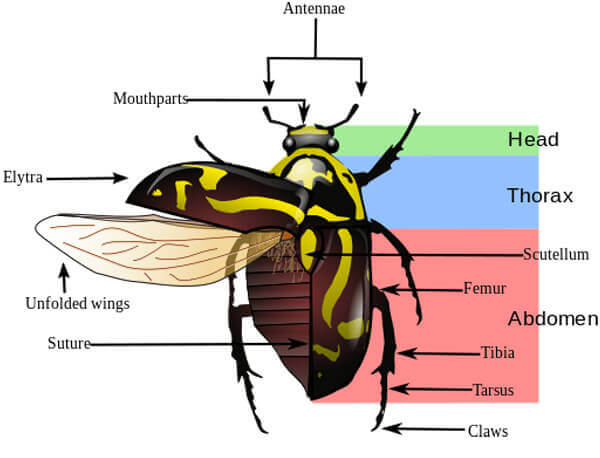Beetles
Scientific Name: Coleoptera
Beetles are one of the most common insects you will encounter, often attempting to enter your home in the late summer months. Some families of beetles can become destructive pests, eating natural fibers like fabrics, feed on wood, damage your lawn by eating grass roots or find their way into the food products you keep in your home.

By Bugboy52.40 (Own work) [CC BY-SA 3.0 or GFDL], via Wikimedia Commons
Beetle Identification
A beetle’s appearance can range from black to brightly colored, depending on which family and species they belong to. The largest of the beetle family is the ground beetle ranging from 1/16th of an inch to 1 inch. One of the smallest is the ladybug, characterized by its bright red or orange shell and black dots.
“Beetles are generally characterized by a particularly hard exoskeleton and hard forewings (elytra). The beetle's exoskeleton is made up of numerous plates, called sclerites, separated by thin sutures. This design provides armored defenses while maintaining flexibility. The general anatomy of a beetle is quite uniform, although specific organs and appendages may vary greatly in appearance and function between the many families in the order. Like all insects, beetles' bodies are divided into three sections: the head, the thorax, and the abdomen.”
Information provided by Wikipedia
All beetles will have chewing mouth parts and antennae on their head but the appearance of these will differ between families. Cockroaches are often mistaken for beetles but they lack the hard outer wing characteristic of the species.
Types of Beetles
- American Spider Beetles
- Cigarette Beetles
- Drugstore Beeltes
- Foreign Grain Beetles
- Larder Beetles
- Red or Confused Flour Beetles
- Shiny Spider Beetles
- Carpet Beetles
- Dried Fruit Beetles
- Elm Leaf Beetles
- Ground Beetles
- Plaster Beetles
- Sawtoothed Beetles
- Merchant Grain Beetles
- Warehouse beetle & cabinet beetles
Beetle Facts
- There are over 350,000 known species of Beetles, making up 28 percent of all living animal species – more than 25.000 have been identified in North America alone.
- Beetles primarily use their wings to retain moisture and for protection - their forewings are hard and thick, protecting the fragile wings folded underneath. Because of this they are actually poor fliers.
- Beetles make their homes in a number of areas: they will tunnel underground, in wood, or in animal remains. Some species will take up residence in ant and termite nests.
Controlling Beetles in Your Home
There are different treatments and methods depending on the type of beetle you have in your home. Our trained and experienced professionals will help you identify the pest beetle in your home and provide guidance on the most effective course of action to control the infestation.
Depending on the type of beetle, a pest control professional may recommend one of the following methods:
- Certain beetles can be removed with the use of a vacuum or other means of physical removal.
- Encapsulating the crawl space under your home will prevent beetles and other pests from making their way inside.
- Inspecting food, wooden items, and fabrics for beetles prior to bringing them home can help prevent further infestations.
- Chemical Growth Regulators will slow down and interrupt a beetle’s reproductive maturity cycle reducing the population in your home.
- In some cases, it may be necessary to utilize chemical pest control products in order to manage your beetle pest problem. In the event they are needed, all safety measures and applications will be done according to best practices and product use directions.
